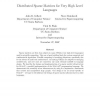Free Online Productivity Tools
i2Speak
i2Symbol
i2OCR
iTex2Img
iWeb2Print
iWeb2Shot
i2Type
iPdf2Split
iPdf2Merge
i2Bopomofo
i2Arabic
i2Style
i2Image
i2PDF
iLatex2Rtf
Sci2ools
101
Voted
AC
2008
Springer
2008
Springer
Distributed Sparse Matrices for Very High Level Languages
Sparse matrices are first class objects in many VHLLs (very high level languages) used for scientific computing. They are a basic building block for various numerical and combinatorial algorithms. Parallel computing is becoming ubiquitous, specifically due to the advent of multi-core architectures. As existing VHLLs are adapted to emerging architectures, and new ones are conceived, one must rethink tradeoffs in language design. We describe the design and implementation of a sparse matrix infrastructure for Star-P, a parallel implementation of the MatlabR programming language. We demonstrate the versatility of our infrastructure by using it to implement a benchmark that creates and manipulates large graphs. Our design is by no means specific to Star-P-- we hope it will influence the design of sparse matrix infrastructures in other languages. 1
Related Content
| Added | 08 Dec 2010 |
| Updated | 08 Dec 2010 |
| Type | Journal |
| Year | 2008 |
| Where | AC |
| Authors | John R. Gilbert, Steve Reinhardt, Viral Shah |
Comments (0)

